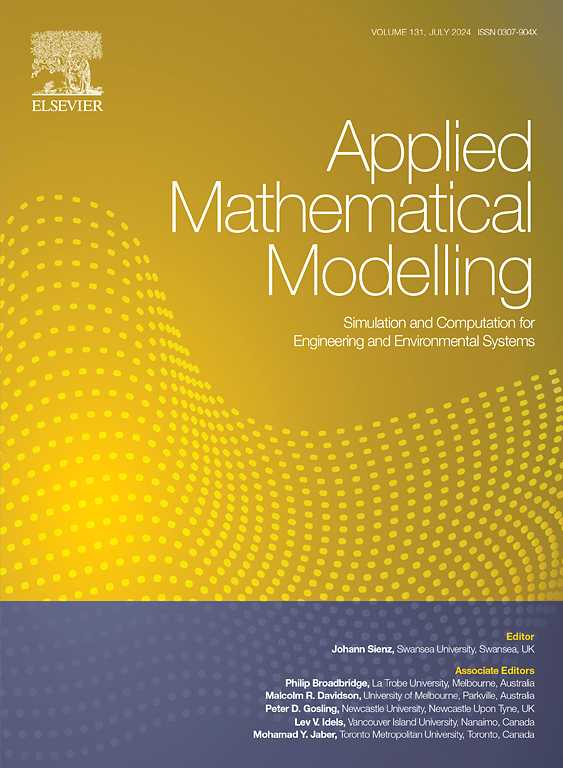Random walk models of advection-diffusion in layered media
IF 4.4
2区 工程技术
Q1 ENGINEERING, MULTIDISCIPLINARY
引用次数: 0
Abstract
Mathematically modelling diffusive and advective transport of particles in heterogeneous layered media is important to many applications in computational, biological and medical physics. While deterministic continuum models of such transport processes are well established, they fail to account for randomness inherent in many problems and are valid only for a large number of particles. To address this, this paper derives a suite of equivalent random walk (discrete-time discrete-space) models for several standard continuum (partial differential equation) models of diffusion and advection-diffusion across a fully- or semi-permeable interface. Our approach involves discretising the continuum model in space and time to yield a Markov chain, which governs the transition probabilities between spatial lattice sites during each time step. Discretisation in space is carried out using a standard finite volume method while two options are considered for discretisation in time. A simple forward Euler discretisation yields a local (nearest-neighbour) random walk with simple analytical expressions for the transition probabilities while an exact exponential discretisation yields a non-local random walk with transition probabilities defined numerically via a matrix exponential. Constraints on the size of the spatial and/or temporal steps are provided for each option to ensure the transition probabilities are in . MATLAB code comparing the random walk and continuum models is available on GitHub (https://github.com/elliotcarr/Carr2024c) with simulation results demonstrating good agreement for several example problems.
分层介质中平流扩散的随机游走模型
非均质层状介质中粒子的扩散和对流输运的数学建模对于计算、生物和医学物理学中的许多应用都是重要的。虽然这种输运过程的确定性连续体模型已经很好地建立起来,但它们无法解释许多问题中固有的随机性,并且仅对大量粒子有效。为了解决这个问题,本文导出了一套等效的随机游走(离散时间-离散空间)模型,用于几个标准的连续介质(偏微分方程)扩散和平流扩散在全渗透或半渗透界面上的模型。我们的方法包括在空间和时间上离散连续体模型以产生马尔可夫链,该链控制每个时间步长期间空间点阵点之间的转移概率。在空间上采用标准有限体积法进行离散,在时间上考虑两种离散方法。简单的前向欧拉离散化产生具有简单过渡概率解析表达式的局部(最近邻)随机游走,而精确的指数离散化产生具有通过矩阵指数数值定义的过渡概率的非局部随机游走。为每个选项提供了对空间和/或时间步骤大小的约束,以确保过渡概率在[0,1]内。比较随机漫步和连续模型的MATLAB代码可在GitHub (https://github.com/elliotcarr/Carr2024c)上获得,仿真结果表明几个示例问题的一致性很好。
本文章由计算机程序翻译,如有差异,请以英文原文为准。
求助全文
约1分钟内获得全文
求助全文
来源期刊

Applied Mathematical Modelling
数学-工程:综合
CiteScore
9.80
自引率
8.00%
发文量
508
审稿时长
43 days
期刊介绍:
Applied Mathematical Modelling focuses on research related to the mathematical modelling of engineering and environmental processes, manufacturing, and industrial systems. A significant emerging area of research activity involves multiphysics processes, and contributions in this area are particularly encouraged.
This influential publication covers a wide spectrum of subjects including heat transfer, fluid mechanics, CFD, and transport phenomena; solid mechanics and mechanics of metals; electromagnets and MHD; reliability modelling and system optimization; finite volume, finite element, and boundary element procedures; modelling of inventory, industrial, manufacturing and logistics systems for viable decision making; civil engineering systems and structures; mineral and energy resources; relevant software engineering issues associated with CAD and CAE; and materials and metallurgical engineering.
Applied Mathematical Modelling is primarily interested in papers developing increased insights into real-world problems through novel mathematical modelling, novel applications or a combination of these. Papers employing existing numerical techniques must demonstrate sufficient novelty in the solution of practical problems. Papers on fuzzy logic in decision-making or purely financial mathematics are normally not considered. Research on fractional differential equations, bifurcation, and numerical methods needs to include practical examples. Population dynamics must solve realistic scenarios. Papers in the area of logistics and business modelling should demonstrate meaningful managerial insight. Submissions with no real-world application will not be considered.
 求助内容:
求助内容: 应助结果提醒方式:
应助结果提醒方式:


